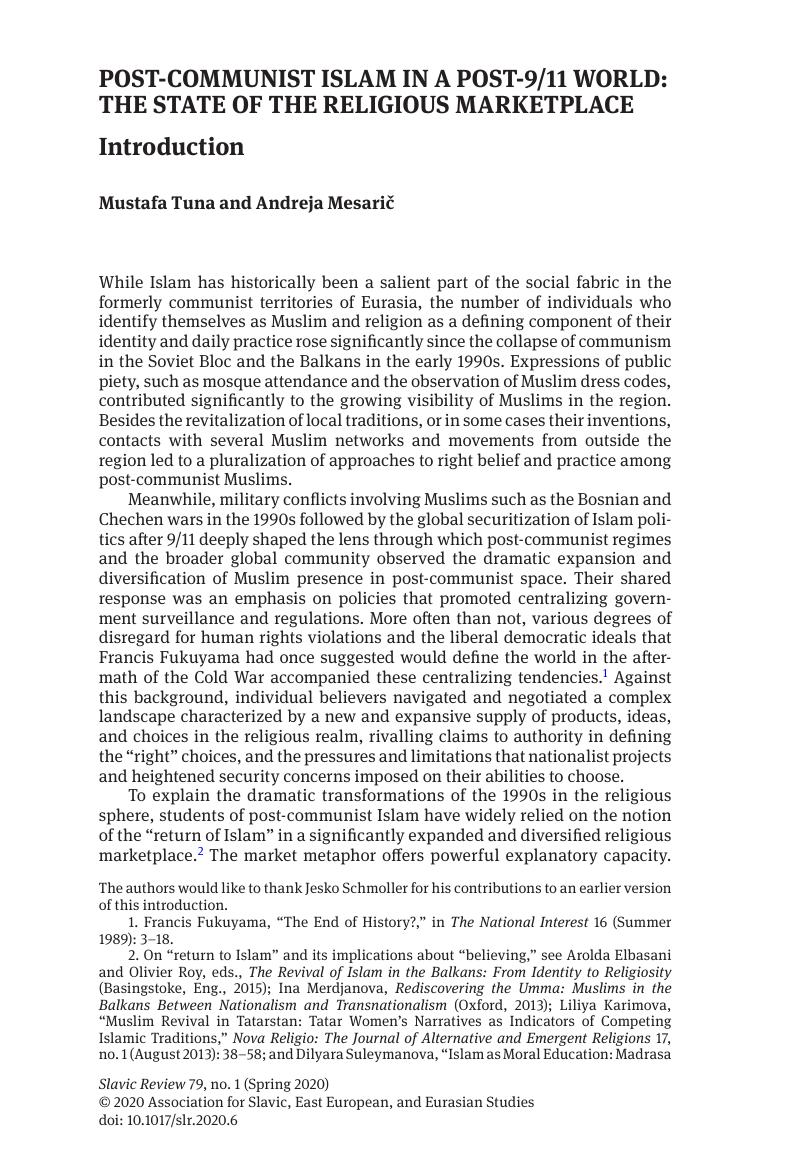No CrossRef data available.
Article contents
Introduction
Published online by Cambridge University Press: 11 May 2020
Abstract

- Type
- Post-Communist Islam in a Post-9/11 World: The State of the Religious Marketplace
- Information
- Copyright
- Copyright © Association for Slavic, East European, and Eurasian Studies 2020
Footnotes
The authors would like to thank Jesko Schmoller for his contributions to an earlier version of this introduction.
References
1 Francis Fukuyama, “The End of History?,” in The National Interest 16 (Summer 1989): 3–18.
2 On “return to Islam” and its implications about “believing,” see Arolda Elbasani and Olivier Roy, eds., The Revival of Islam in the Balkans: From Identity to Religiosity (Basingstoke, Eng., 2015); Ina Merdjanova, Rediscovering the Umma: Muslims in the Balkans Between Nationalism and Transnationalism (Oxford, 2013); Liliya Karimova, “Muslim Revival in Tatarstan: Tatar Women’s Narratives as Indicators of Competing Islamic Traditions,” Nova Religio: The Journal of Alternative and Emergent Religions 17, no. 1 (August 2013): 38–58; and Dilyara Suleymanova, “Islam as Moral Education: Madrasa Courses and Contestation of the Secular in the Republic of Tatarstan, Russia,” Religion, State & Society 43, no. 2 (2015): 150–67.
3 On the growing salience of these conservative notions, see Mikhail Suslov, “‘Holy Rus’: The Geopolitical Imagination in the Contemporary Russian Orthodox Church,” Russian Politics and Law 52, no. 3 (2014): 67–86; Marlene Laruelle, “The Notion of Eurasia: A Spatial, Historical and Political Construct,” in Edward Holland and Matthew Derrick, eds., Questioning Post-Soviet (Washington, D.C., 2016), 127–40; and Irina du Quenoy, “Russia: The Stability Implications of State Policies Toward Religion and the Russian Orthodox Church,” in Katya Migacheva and Frederick Bryan, eds., Religion, Conflict, and Stability in the Former Soviet Union (Santa Monica, CA., 2018), 159–80.
4 On anti-Muslim discrimination in Russia, see Alexander Verkhovsky, “Russian Approaches to Radicalism and ‘Extremism’ as Applied to Nationalism and Religion,” in Roland Dannreuther and Luke March, eds., Russia and Islam: State, Society and Radicalism (New York, 2010), 26–43; Marlene Laruelle and Natalia Yudina, “Islamophobia in Russia: Trends and Societal Context,” in Olga Oliker, ed., Religion and Violence in Russia: Context, Manifestations, and Policy (Lanham, MD.: Rowman and Littlefield; Washington, D.C., Center for Strategic and International Studies, 2018), 43–62; Vera Tolz and Sue-Ann Harding, “From ‘Compatriots’ to ‘Aliens’: The Changing Coverage of Migration on Russian Television,” Russian Review 74, no. 3 (July 2015): 452–77.
5 “Managing Islam and Religious Pluralism,” a special issue of Journal of Balkan and Near Eastern Studies 19, no. 1 (2017), Ahmet Alibašić and Nedim Begović, “Reframing the Relations between State and Religion in Post-War Bosnia: Learning to be Free!”: 19–34.
6 Li, Darryl, “A Universal Enemy?: ‘Foreign Fighters’ and Legal Regimes of Exclusion and Exemption Under the ‘Global War on Terror,’” Columbia Human Rights Law Review 41, no. 2 (2010), 355–428Google Scholar; Christian Moe, “The War on Terror and Muslim Opinion-Making in Bosnia,” in Anne Stensvold, ed., Western Balkans: The Religious Dimension (Oslo, 2009), 91–183.
7 Mahmood Mamdani, Good Muslim, Bad Muslim: America, the Cold War, and the Roots of Terror (New York, 2004).




